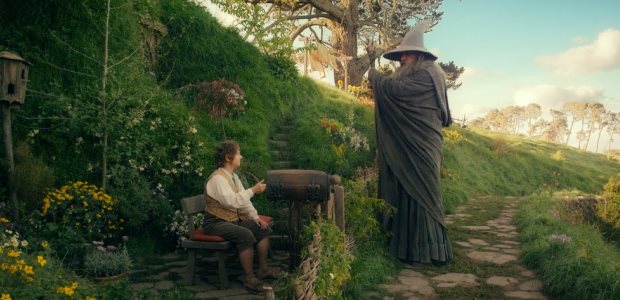Peter Jackson, who redefined the words “epic”, “fantasy” and “trilogy” with The Lord Of The Rings movies, now brings us a new set of films that again fall under those three words, with the addition of the word “prequel”. The Hobbit: An Unexpected Journey, the first of the prequel trilogy, is all that it was marketed to be, and more. But more isn’t always better. While An Unexpected Journey does suffer from excess in exposition, it delivers on entertainment. And while Peter Jackson’s love for excess should have been reined in to make this a better film, fans of Tolkien will recognize the same excess as his passion for the source material.
Starting on familiar grounds, the movie re-introduces us to an old Bilbo Baggins (Ian Holm), before taking us via flashback to his younger self (Martin Freeman), the arrival of Gandalf the Grey (Ian McKellen) at his home and a journey they take together with thirteen dwarves. The quest is to retake the Lonely Mountain and the treasures within. Known earlier as Erebor, a majestic kingdom of dwarves, it was taken and stays occupied by the fearsome dragon Smaug who sleeps on the massive treasure. While this movie deals with a portion of the journey towards the mountain, Bilbo faces enough adventures and perils on the way to make him wonder, and not just once, whether he should have even gone on this journey. On the way, he will also meet many friends and foes; some of them being familiar faces of Middle-earth.
J. R. R. Tolkien had written The Hobbit and The Lord of the Rings as two separate works with different target readerships — the former is a children’s book, while the latter is for grown-ups. Since the audience for the movies adapted from these books is the same, the toughest task for Peter Jackson and team in adapting The Hobbit for film would have been to retain the consistency of visual and emotional tone of the previously released trilogy, yet be true to the gullibility of the book’s tale. While it mostly works, An Unexpected Journey stumbles in the first act. It takes too long to get the journey started, and when it does, it seems very little distance is covered (although a lot happens on the way). Being a children’s book The Hobbit skipped a lot of details. Being true purely to the book would make for erratic story-telling on celluloid — it would effectively leave Gandalf as a jack-in-the-box character, popping in and out of the tale as per the situation’s needs — but including details to fill in those gaps becomes tedious for the movie.
Where Peter Jackson does succeed is in the sense of fun he brings to the movie’s set-pieces. The scene with Gollum, one of the best chapters of the book, likewise becomes the best sequence of the movie. An underground battle with goblins, while goofy at times, is tremendously exciting to watch. It is a welcome sight to have Ian McKellen back as Gandalf, undoubtedly the best of all Middle-earth character-portrayals. He is ably joined by Martin Freeman who perfectly embodies Bilbo Baggins. Together, they are the driving force of the narrative — a conscious decision of the film-makers that pays off.
It will not be easy to watch The Hobbit: An Unexpected Journey without an extreme expectation. For some, since the last visit to Middle-earth via The Lord Of The Rings: Return Of The Kings swept the box-office, critics and the Oscars, the hope will be for a a movie nothing short of the best in popular cinema. But there will be those who consider adapting a 300-odd page children’s book into three 3-hour movies seems like a cash-grab opportunity. It is important to remember that An Unexpected Journey is not The Lord Of The Rings. To completely enjoy this film, it is essential to leave it all behind and just go along on the cinematic adventure!
Rating: 




